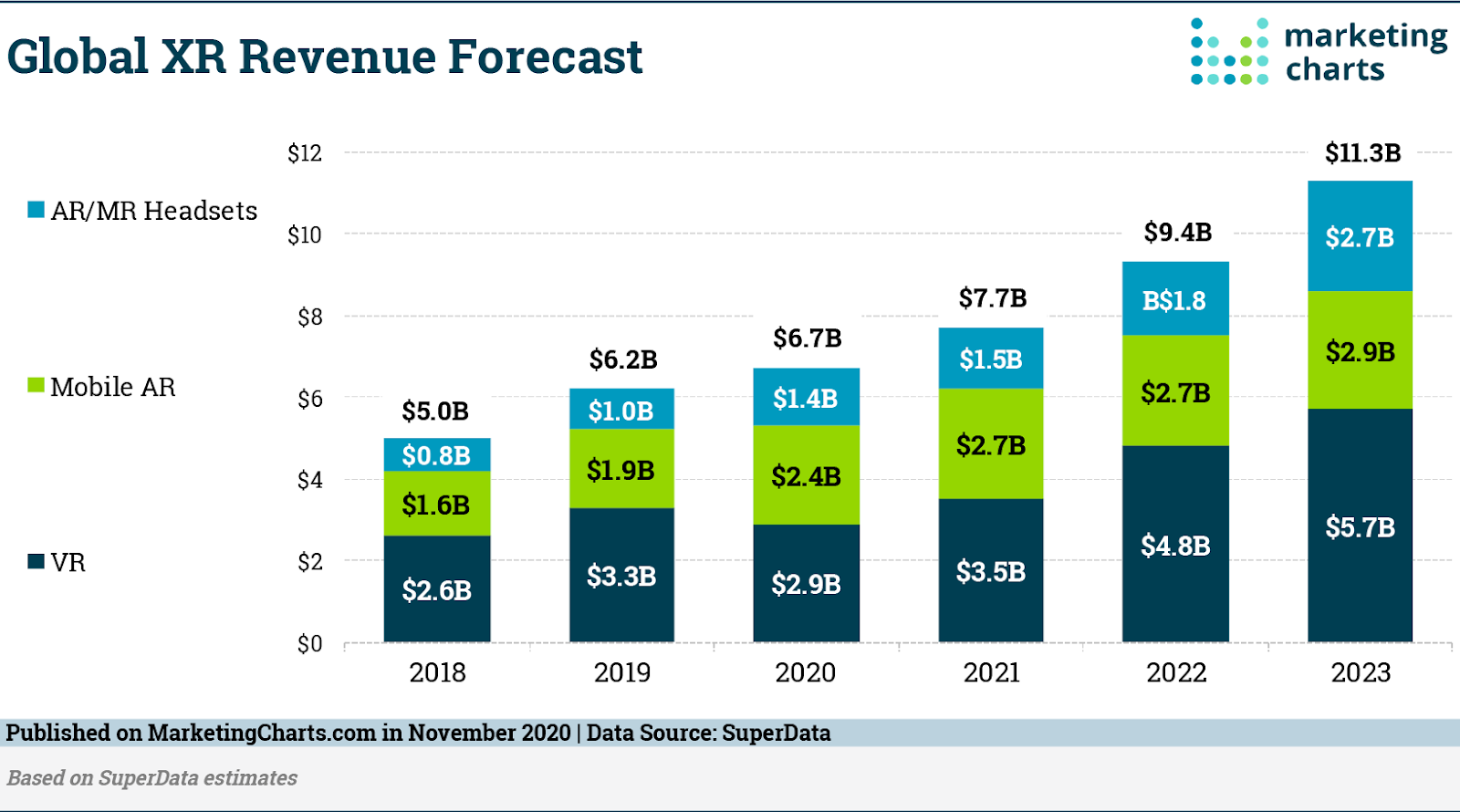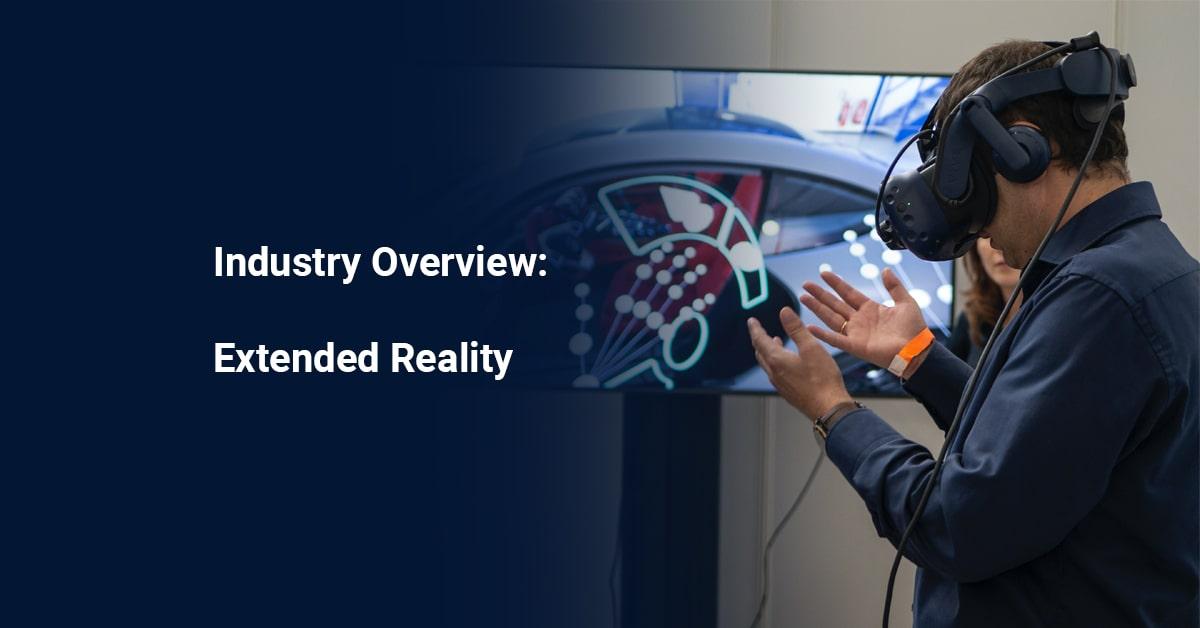SeedBlink Blog
technology Trends
Extended Reality (XR) - Industry Overview
Extended Reality is the industry sector acting as an umbrella for VR, AR, and MR technologies. The ecosystem is growing, and more startups are coming to life, but is it the right to invest?
As more and more of our lives are becoming digital, from work to daily shopping or entertainment, we discover new enhanced experiences. XR, or Extended Reality, supports the development of these experiences through the power of virtual reality, augmented reality, and mixed reality applications.
But what is precisely XR, and is it worth the hype?
In this article, you’ll embark on a little journey around this fascinating and growing industry to learn some of the essential elements and discover why it’s one of the areas to bet on as an investor.
Let’s start by taking a look at what extended reality is and which are its main components!
What is XR — extended reality?
XR, also known as eXtended Reality, is an umbrella term encompassing a range of technologies that allow users to experience and interact with virtual or augmented environments in a real and immersive way.
Gradually moving from hype to reality, this technology is creating value across multiple sectors of the economy and society, from education, training, design, real estate, and entertainment. XR technologies include:
- virtual reality (VR) - which fully immerses users in a virtual environment;
- augmented reality (AR) - overlays virtual objects and information onto the real world;
- mixed reality (MR) - combines VR and AR elements.
As we can see, the extended reality is not a technology element per se but the meeting point between these three strong forces. To fully understand these elements, let’s dive into each one individually.
What is VR — virtual reality?
Virtual Reality (VR) is a simulated 3D world that is discovered and experienced in a way that feels close to reality through devices and wearables.
The headsets you wear during a VR experience track your movement and adjust the visual representation accordingly to create a more immersive experience. Hand controllers accompany headsets to read your hand movements, translate your actions into the digital world, and let you enjoy a version closer to reality. This way, users immerse themselves in the virtual world, and developers can create better experiences by programming those through computer software.
What is AR — augmented reality?
Compared to VR, augmented reality (AR) is a type of technology that brings digital elements into the real world with the help of different mobile devices and, in some cases, wearables.
Augmented reality was designed initially to enhance the customer experience in the e-commerce sector and expand its capabilities across multiple sectors, which we’ll explore later in the article. With the expansion of technology in diverse ways, people can simulate a product or experience in advance and see its real benefits.
What is MR — mixed reality?
If Virtual Reality is about the digital world and Augmented Reality is about the natural world we live in, Mixed Reality (MR) technology combines both worlds. This technology can include understanding various elements, such as the environment surrounding us, human behaviour, surfaces, locations, object positions, and spatial lights or sounds.
Mixed Reality uses cameras, sensors, and sometimes other AI-powered technologies to gather and analyze the data and see how it can enhance it with digital elements.
The evolution of XR in 2022
The global extended reality market size at the end of 2022 reached 25.2BN USD, growing +20% compared to the previous year. The industry value is expected to have a “full boom” over the following years and reach 250BN USD by 2028.
The evolution of the metaverse has shown us the massive potential of what is possible to build through social technologies. Tech giants like Meta and Microsoft or gaming companies such as Roblox or Epic are just some of the resounding names investing massively in XR. Beyond their efforts, innovation in the industry comes to life from different parts of the world, with more startups being created and new ideas disrupting existing legacy systems.

Source: XR Industry growth by Marketing Charts
The growth of the extended reality industry in 2023 is forecasted to grow even more, with AR becoming more familiar and embedded with artificial intelligence and metaverse gaining more traction.
This year, the industry awaits new updates from Meta after the launch of the Meta Quest Pro headset, which brought better avatars and new features. Alongside tech companies, we have brands like BMW or Nike tackling this technology to improve their communication, product development, or customer service, which brings significant transformations for enterprise companies.
The usage of XR in different industries
Using extended reality technologies across different sectors proved how many boundaries can be overcome and how many benefits we can get by integrating them into our constant practice.
Here are a few examples of VR, AR, and MR usage and how they improve ecosystems across different industries.
VR examples
Virtual Reality in Gaming
The gaming sector has claimed one of the most popular use cases of virtual reality, guiding people to explore new digital worlds.
Best VR applications in Gaming:
- Steam VR - an online platform filled with content designed for virtual reality, ready-to-play games, and a community of other keen passionates of the digital world.
- Beat Saber - is a virtual reality game available on Oculus Rift, HTC Vive/Steam, and PlayStation VR, and it’s one of the most popular in its category. It’s a music-rhythm game where you have two lightsabers and have to destroy slash blocks coming from different directions or avoid obstacles by keeping the music rhythm playing in the background.
Virtual Reality in Medicine
The integration of VR in the healthcare sector improved many areas, including finding clinical training, disease prevention, eliminating treatment or diagnosis errors, and ensuring efficient care.
This type of technology reduces costs and improves operational processes in different ways. For example, medical students could no longer need human corpses to test their practical skills and take virtual classes on the human body without risking the life of actual patients.
Best VR applications in Medicine:
- 3D Organon - a medical & healthcare education platform for teaching and learning anatomy across virtual reality, desktop, tablet, and mobile devices.
- Amelia - an online VR platform offering a complementary tool for mental health professionals to use during interventions in treatment for post-traumatic stress disorders and other mental illnesses, including phobias and anxiety.
Virtual Reality in Education
Virtual reality offers a wide range of opportunities for the educational sector by enhancing the learning/teaching process, making the learning process more enjoyable and easier to understand, and providing in-depth knowledge on different topics through immersive experiences. Among the most common use cases in the sector, we find:
- An enhanced learning experience processes through better visualization of 2D objects and experiencing possible fabricated scenarios in advance.
- An alternative solution for joining distance learning where universities have already held their first classes in “the metaverse” world.
- Prepare students for real-life experiences and professional jobs through virtual labs that allow them to “taste” a real-life job, nurture their skills, and become familiar with a professional environment.
In the education sector, schools and universities can also create a blended learning experience by bringing students into virtual smart classrooms. Blending virtual reality with traditional learning makes studying more appealing for students and transforms a tedious or difficult study process.
Best VR applications in Education:
- Unimersiv - a virtual world through which you can travel in time and experience different historical events or learn how the human body works. The platform is designed to be used by individual people and teachers in the classroom.
- Ocean Rift - biology teachers can use this application to take their students on tour around a unique aquatic safari park. This way, they can explore the world underwater more immersively and learn more about marine life.
AR examples
Augmented Reality for Interior Design
Augmented Reality started to be used by architects, furniture developers, retail companies, and interior design specialists to create interactive experiences for their clients. This way, you can place and test out how a particular piece of furniture or design will look right in your room.
Best AR applications in Interior Design
- IKEA Place - IKEA Place lets you virtually ‘place’ furnishings in your space. From sofas and lamps to rugs and tables, all of the products in IKEA Place are 3D and true to scale, so you can make sure it’s just the right size, design, and functionality for your room.
- AR-media by Inglobe Technologies - AR-media allows you to visualize your Augmented Reality Interior Design configuration in real-time, making it easy to find the best layout with your 3D models.
Augmented Reality in Finance
With constant innovation coming in the financial industry, companies and banks are embracing new intelligent solutions and modern technologies.
For example, banks can use Augmented Reality to help their customers locate ATMs and the nearest local offices in their area or utilize it to automate internal processes. Financial analysts can use AR to collect real-time data and transform it into various new formats.
Best AR applications in Finance
- StockCity - a platform created by Fidelity Labs, part of Fidelity Investments, offers a virtual world where stock portfolios are turned into virtual 3D cities. Here, investors can experience data in their hands and immerse themselves in the world around them.
- Citi HoloLens Holographic Workstation - a virtual trading desk developed by Citi Bank using Microsoft HoloHels to understand what is happening with the massive amount of data behind traders and deals.
XR startup raising funding through SeedBlink
QuarkXR
QuarkXR is a Bulgarian B2B SaaS startup using streaming technology and cloud computing to turn any XR headset into a supercomputer. They have developed the largest cloud streaming platform regarding the number of Enterprise XR use cases. Compared to its industry peers, its open platform is device & industry-agnostic, enabling enterprise use cases otherwise impossible on Meta Quest.
QuarkXR hosts XR content on Cloud servers with GPUs. A Cloud GPU is generally ten times more powerful than a mobile device like the Meta Quest. Each frame of XR content on the Cloud server is compressed and streamed in real time with zero latency to the XR headset. This approach allows us to have fully interactive experiences and enable Enterprise applications such as training, design, collaboration, etc. Any Enterprise use case is possible with QuarkXR.
The company targets a €10bln market in industries like Telecom, Manufacturing, Automotive, and Architecture. However, the applicability of the product can be easily expanded in other sectors, such as healthcare, human resources, defence, or entertainment.
QuarkXR has an active round right now on Seedblink, starting with 725.000 EUR pre-committed money and targeting a total investment of 875.000 EUR.
Join our newsletter
Your go-to source for European startup news, equity trends, VC insights, and investment opportunities.
